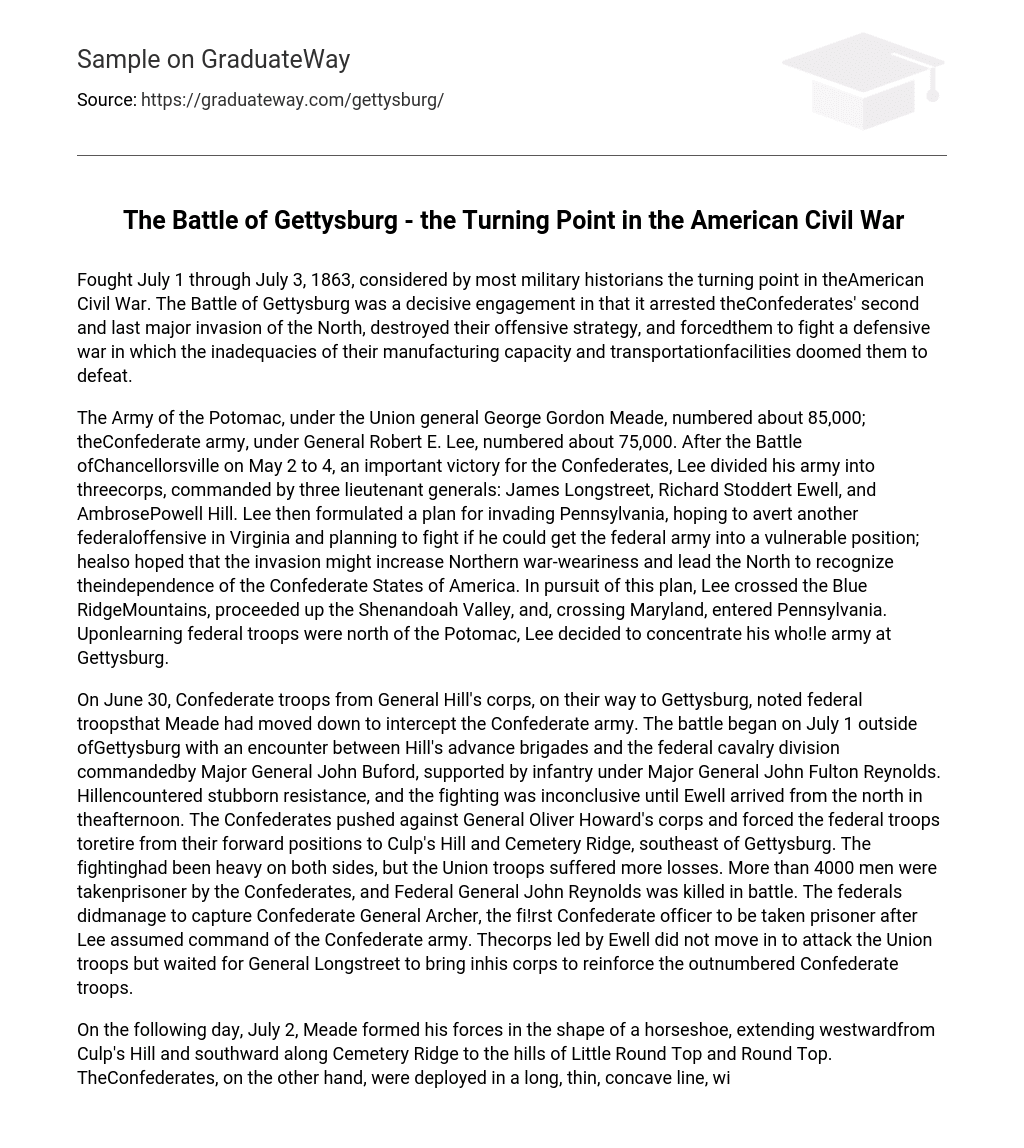Fought July 1 through July 3, 1863, considered by most military historians the turning point in theAmerican Civil War. The Battle of Gettysburg was a decisive engagement in that it arrested theConfederates’ second and last major invasion of the North, destroyed their offensive strategy, and forcedthem to fight a defensive war in which the inadequacies of their manufacturing capacity and transportationfacilities doomed them to defeat.
The Army of the Potomac, under the Union general George Gordon Meade, numbered about 85,000; theConfederate army, under General Robert E. Lee, numbered about 75,000. After the Battle ofChancellorsville on May 2 to 4, an important victory for the Confederates, Lee divided his army into threecorps, commanded by three lieutenant generals: James Longstreet, Richard Stoddert Ewell, and AmbrosePowell Hill. Lee then formulated a plan for invading Pennsylvania, hoping to avert another federaloffensive in Virginia and planning to fight if he could get the federal army into a vulnerable position; healso hoped that the invasion might increase Northern war-weariness and lead the North to recognize theindependence of the Confederate States of America. In pursuit of this plan, Lee crossed the Blue RidgeMountains, proceeded up the Shenandoah Valley, and, crossing Maryland, entered Pennsylvania. Uponlearning federal troops were north of the Potomac, Lee decided to concentrate his who!le army at Gettysburg.
On June 30, Confederate troops from General Hill’s corps, on their way to Gettysburg, noted federal troopsthat Meade had moved down to intercept the Confederate army. The battle began on July 1 outside ofGettysburg with an encounter between Hill’s advance brigades and the federal cavalry division commandedby Major General John Buford, supported by infantry under Major General John Fulton Reynolds. Hillencountered stubborn resistance, and the fighting was inconclusive until Ewell arrived from the north in theafternoon. The Confederates pushed against General Oliver Howard’s corps and forced the federal troops toretire from their forward positions to Culp’s Hill and Cemetery Ridge, southeast of Gettysburg. The fightinghad been heavy on both sides, but the Union troops suffered more losses. More than 4000 men were takenprisoner by the Confederates, and Federal General John Reynolds was killed in battle. The federals didmanage to capture Confederate General Archer, the fi!rst Confederate officer to be taken prisoner after Lee assumed command of the Confederate army. Thecorps led by Ewell did not move in to attack the Union troops but waited for General Longstreet to bring inhis corps to reinforce the outnumbered Confederate troops.
On the following day, July 2, Meade formed his forces in the shape of a horseshoe, extending westwardfrom Culp’s Hill and southward along Cemetery Ridge to the hills of Little Round Top and Round Top. TheConfederates, on the other hand, were deployed in a long, thin, concave line, with Longstreet and Ewell onthe flanks and Hill in the center.
Lee, against the advice of Longstreet and despite the fact that he had no cavalry, resolved to attack thefederal positions. Longstreet was unable to advance until late afternoon, thus allowing the federal troops tomake preparations for the expected assault. General Abner Doubleday of the federal army strengthened hishold on Cemetery Hill. The federals held Cemetery Ridge and Little Round Top, but Longstreet movedConfederate troops along Peach Orchard, driving the federals from their positions there. Although Ewellwon part of Culp’s Hill, he was unable to break the federal line there or on the eastern part of CemeteryRidge. On the night of July 2, Meade held a council of war in which the decision was made not to retreat.
On the third day of battle, the federals were secure in their positions and the Confederates had lost theiroffensive stance. General Lee decided to mount an attack despite opposition from other Confederategenerals. The offensive did not begin until afte!r noon. Groups from three Confederate divisions, including the division led by Major General George E.
Pickett, totaling fewer than 15,000 men, took part in a memorable charge on Cemetery Ridge against awithering barrage of federal artillery and musket fire. The attack is known as Pickett’s Charge. Althoughthe Confederate troops breached Meade’s first line of defense, the strain on the Confederates proved toogreat, and they fell back, having lost over three-fourths of their force.
With the repulse of Pickett’s Charge, the Battle of Gettysburg was virtually over. On the night of July 4,Lee began his retreat to Virginia, expecting a counterattack from the federal army. Meade, however, did notattack, due perhaps to heavy rains which hampered pursuit of the retreating Confederates. During the threedays of battle, the federal army lost 3070 killed, 14,497 wounded, and 5434 captured or missing. TheConfederates lost about 3500 killed, 18,000 wounded, and 5150 captured or missing.





